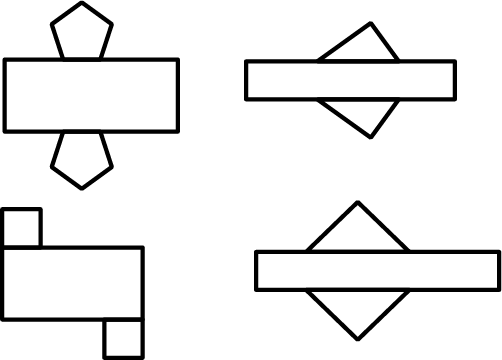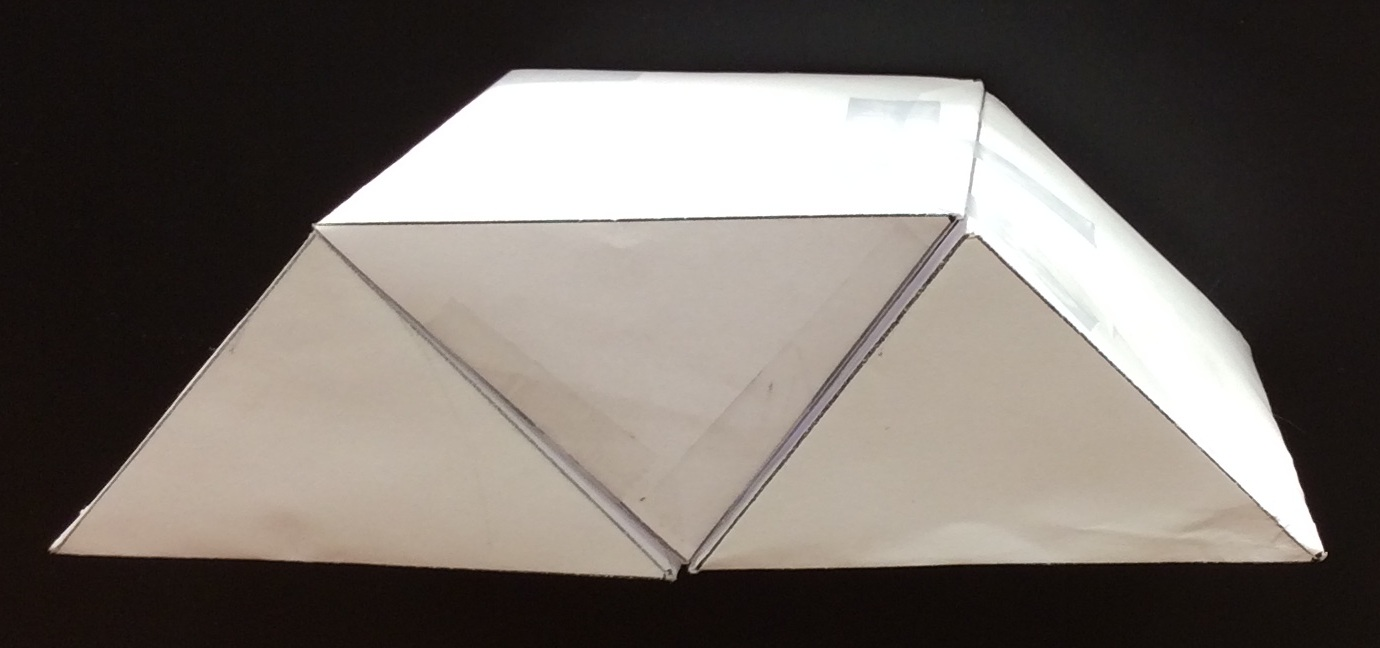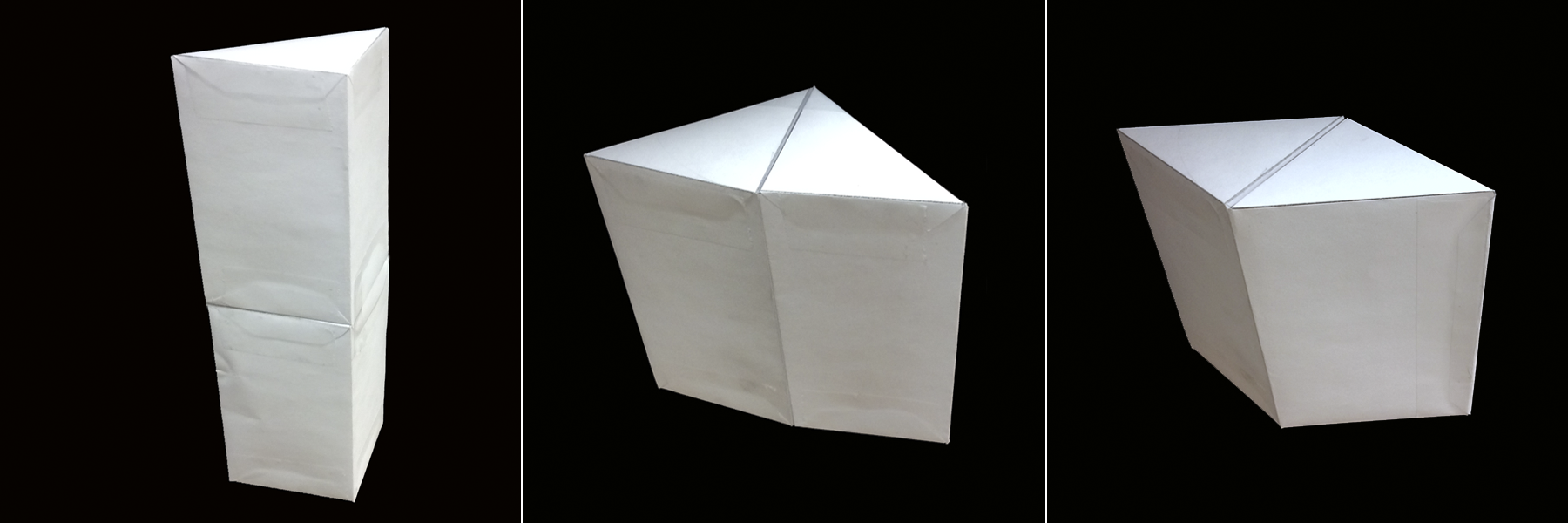Lesson 26
Building Prisms
26.1: Nets (5 minutes)
Warm-up
The purpose of this warm-up is for students to reason about prisms formed from various nets. During the partner and whole-group discussions, listen for how students name each prism: pentagonal prism, triangular prism, square prism (but not a cube), and select students who correctly name each prism to share during the whole-group discussion.
Launch
Arrange students in groups of 2. Give students 30 seconds of quiet think time to look at the nets followed by 2 minutes to describe each net with a partner.
Student Facing
Here are some nets for various prisms.

-
What would each net look like when folded?
- What do you notice about the nets?
Student Response
For access, consult one of our IM Certified Partners.
Activity Synthesis
Ask selected students to describe the object formed by each net. Record and display their responses for all to see. If a student's description does not include the name of the prism, ask other students to name the object and explain how they know.
Ask students to share what they notice about all of the nets. Record and display their responses for all to see. While students may notice many things, important ideas to highlight during the discussion are:
- They all have a long rectangle in the middle.
- The bases on top and bottom are upside down.
- There’s one base on each side of the rectangle.
26.2: Making the Base (10 minutes)
Optional activity
This activity reviews the work students did previously drawing shapes with given conditions. Students draw as many different triangles as they can that could be the base of the triangular prism, given two side lengths and one angle measure for the triangle.
In preparation for calculating surface area and volume in the next activity, students select one of their triangles and find its area. This will require them to draw and measure the height of the triangle. As needed, remind students that the height must be perpendicular to whichever side they are using as the base of their triangle. Also, prompt students to measure the height as precisely as possible, because it will influence the accuracy of their later calculations.
Launch
Provide access to geometry toolkits and compasses.
Student Facing
The base of a triangular prism has one side that is 7 cm long, one side that is 5.5 cm long, and one angle that measures \(45^\circ\).
-
Draw as many different triangles as you can with these given measurements.
-
Select one of the triangles you have drawn. Measure and calculate to approximate its area. Explain or show your reasoning.
Student Response
For access, consult one of our IM Certified Partners.
Anticipated Misconceptions
Students may try to multiply two side lengths of the triangle to calculate the area. Remind them that the height must be perpendicular to the base. If necessary, demonstrate using an index card to draw in the height of the triangle.
Activity Synthesis
Ask students to share triangles they drew so that everyone has an opportunity to see all four triangles. If any of the four triangles are not presented by students, demonstrate how to construct it. Ensure the class agrees that 4 unique triangles have the given measurements. The third side length of the triangle could be 5.0 cm, 7.3 cm, 2.6 cm, or 9.7 cm.
Make sure students have calculated the area of their selected triangle correctly, because this will affect their volume and surface area calculations in the next activity.
| If the third side of the triangle is | then the area of the triangle should be about | possible strategies |
|---|---|---|
| 5.0 cm | 13.7 cm2 |
\(\frac12 \boldcdot 7 \boldcdot (3.9)\) or \(\frac12 \boldcdot (5.5) \boldcdot (5.0)\) |
| 7.3 cm | 18.2 cm2 |
\(\frac12 \boldcdot 7 \boldcdot (5.2)\) or \(\frac12 \boldcdot (5.5) \boldcdot (6.6)\) or \(\frac12 \boldcdot (7.3) \boldcdot (5.0)\) |
| 2.6 cm | 6.3 cm2 |
\(\frac12 \boldcdot 7 \boldcdot (1.8)\) or \(\frac12 \boldcdot (5.5) \boldcdot (2.3)\) or \(\frac12 \boldcdot (2.6) \boldcdot (5.0)\) |
| 9.7 | 18.9 cm2 |
\(\frac12 \boldcdot 7 \boldcdot (5.4)\) or \(\frac12 \boldcdot (5.5) \boldcdot (6.9)\) or \(\frac12 \boldcdot (9.7) \boldcdot (3.9)\) |
Design Principle(s): Maximize meta-awareness
26.3: Making the Prism (10 minutes)
Optional activity
In this activity, students take the triangle they selected in the previous activity and use it as the base of their triangular prism. After students have drawn their net and before they cut it out and assemble it, make sure they have correctly positioned their bases, opposite from each other on the top and bottom of the rectangle and reflected. It will also make assembling the net easier for students if they draw lines subdividing the large rectangle into the individual rectangular faces and draw tabs where the faces will be glued or taped together.
Launch
Demonstrate the positions triangles should attach to the rectangle to form a net by displaying an example and describing the important parts:
- The triangles must have a vertex at \(A\) and \(C\).
- The triangles must be identical copies with one “upside down” from the other.
- Corresponding sides of each triangle must be along the side of the rectangle.

Supports accessibility for: Organization; Attention
Student Facing
Your teacher will give you an incomplete net. Follow these instructions to complete the net and assemble the triangular prism:
- Draw an identical copy of the triangle you selected in the previous activity along the top of the rectangle, with one vertex on point \(A\).
- Draw another copy of your triangle, flipped upside down, along the bottom of the rectangle, with one vertex on point \(C\).
- Determine how long the rectangle needs to be to wrap all the way around your triangular bases. Pause here so your teacher can review your work.
- Cut out and assemble your net.
After you finish assembling your triangular prism, answer these questions. Explain or show your reasoning.
- What is the volume of your prism?
-
What is the surface area of your prism?
-
Stand your prism up so it is sitting on its triangular base.
- If you were to cut your prism in half horizontally, what shape would the cross section be?
- If you were to cut your prism in half vertically, what shape would the cross section be?
Student Response
For access, consult one of our IM Certified Partners.
Activity Synthesis
Select students to share their answers for the cross sections. For cross sections taken in these two ways, all triangular prisms should have the same shapes as answers although the actual size of the cross section will differ based on the size of the base triangle and the height of the prism.
The volume and surface areas will depend on the triangle they have chosen to use as their base.
Select students to share their methods for computing volume and surface area. The base area is important in the calculation of each, so students should use the values they computed in the previous activity.
Design Principle(s): Optimize output (for explanation)
26.4: Combining Prisms (10 minutes)
Optional activity
Students combine their solid with a partner’s and examine the new solid’s properties.
If there is time, this activity can be extended to review relationships between angles as well.
- Take two of the prisms and put them together so that their \(45^\circ\) angles are adjacent. Ask students what type of angle is created and what the relationship between the two angles creating that angle must be. (a right angle, complementary angles)
- Take three identical prisms and put them together so that a different angle from each prism is adjacent.

Launch
Arrange students in groups of 2.
Supports accessibility for: Attention; Social-emotional skills
Student Facing
- Compare your prism with your partner’s prism. What is the same? What is different?
- Find a way you can put your prism and your partner’s prism together to make one new, larger prism. Describe your new prism.
- Draw the base of your new prism and label the lengths of the sides.
-
As you answer these questions about your new prism, look for ways you can use your calculations from the previous activity to help you. Explain or show your reasoning.
- What is the area of its base?
- What is its height?
- What is its volume?
- What is its surface area?
Student Response
For access, consult one of our IM Certified Partners.
Student Facing
Are you ready for more?
How many identical copies of your prism would it take you to put together a new larger prism in which every dimension was twice as long?
Student Response
For access, consult one of our IM Certified Partners.
Anticipated Misconceptions
Student might struggle trying to measure and calculate the area of the base of their new prism if it is an irregular quadrilateral. Prompt them that they can just add the areas of the bases of their individual prisms together.
Activity Synthesis
Discuss which attributes of the larger prisms were easiest to determine based on the original prisms and which were hardest.
Using two prisms that are identical, demonstrate putting them together against a matching side various ways.

In the first configuration,
- The area of the base is the same as in the original prism.
- The height is twice the height of the original prism.
- The volume is twice the volume of the original prism.
- The surface area is less than twice the surface area of the original prism (because of the sides that are put together).
In the second and third configurations,
- The area of the base is twice the original.
- The height is the same as the original.
- The volume is twice the original.
- The surface area is less than twice the original.
How could you put these two prisms together to make the largest surface area possible for the new prism? The smallest surface area possible?
Design Principle(s): Support sense-making; Optimize output (for explanation)
Lesson Synthesis
Lesson Synthesis
Ask students to reflect on what they have learned in this unit, either in writing or by talking to a partner. Here are some suggested prompts:
- “What is something you learned in this unit that surprised you?”
- “What is a new mathematical word you learned in this unit, and what does it mean?”
- “What is an idea that you learned about in this unit that is useful in the real world?”
- “Describe something that you were confused about at first, but understand now.”
- “Describe something that you found challenging, but understood with some effort.”
- “What is something from this unit that you are still wondering about?”
- “What was your favorite activity, and what did you learn from it?”